from "Lost Highway" by Peter Guralnick
my painting of the maestro - "Rufus Goes to Heaven" by Charlie Dyer
Rufus Thomas
Born March 26, 1917, in Cayce, Mississippi. Children include Carla, Marvell, and Vanesse.
Career
Began performing with the Rabbit Foot Minstrel Show, 1936; recorded his first record, "I'll Be A Good Boy," for the Texas-based Star Talent label, 1943; began working as a DJ at WDIA radio in Memphis, 1952; recorded "Bear Cat," the first hit for Sun Records, 1953; recorded "Cause I Love You" with daughter Carla for new Satellite (later Stax) record label, 1960; recorded top 10 hit "Walking the Dog," 1963; recorded "Do the Funky Chicken," 1970; appeared at Wattstax festival, 1972; recorded "Do the Funky Penguin," 1972; appeared in film Mystery Train, 1989; Rufus Thomas Park dedicated in Poretta Torme, Italy, 1990.
Life's Work
With hits like "Walking the Dog," "Do the Funky Chicken," and "Do the Funky Penguin," Rufus Thomas often gets dismissed as a singer who has had little to offer beyond novelty dance tunes. Those who have gone deeper into the Thomas catalog and the history of American rhythm and blues know better. As Hugh Gregory, the author of Soul Music A-Z, put it, "The name Rufus Thomas has been synonymous with the term 'soul music,'" and Billboard's Steve Greenberg goes a few steps further declaring that Thomas's life story, "encapsulates the history of African-American entertainment in this century." Both are correct. As a minstrel performer, as a disc jockey on Memphis's historic WDIA radio where he is still heard every Saturday morning after nearly 50 years, and as a recording and touring artist, Thomas is a true pioneer.
Born the son of a sharecropper on March 26, 1917 in Cayce, Mississippi, Rufus moved with his family to Memphis when he was a young boy. Before he was ten years old, Thomas was already a veteran of the city's amateur shows where he would sing and tap- dance. Following high school Thomas began a full-time show business career and learned the art of being an entertainer by traveling through the South with the Rabbit Foot Minstrel Show. "It was truly an experience," Thomas told the author of Goin Back to Memphis, James Dickerson. "They had high-stepping dancers, comics, singers; they had it all. That was during the days of separation, where the whites were on one side and the blacks were on the other. Man, we had some of the greatest shows ever."
With a young family to support in Memphis, Thomas left the road to earn a living tending boilers at a textile bleaching mill. A perpetual performer however, he found time in the evenings and on weekends to host the amateur night competitions at the Palace and Handy theaters where performers such as B.B. King, Bobby "Blue" Bland, and Johnny Ace made their initial appearances. In 1943 Thomas recorded his first record, "I'll Be A Good Boy," for the Texas-based Star Talent label, but it failed to do well. "It sold five copies, and I bought four of them," he confessed to Steve Greenberg of Billboard.
In 1948 an experiment by the two white owners of radio station WDIA altered Thomas's life as well as just about everyone else's in the 50,000-watt listening area. The station was failing financially so the owners decided they had nothing to lose by going after the rapidly increasing black audience by playing black-oriented music using an all-black on-air staff. The first on-air personality and program director was teacher and community leader Nat D. Williams, who had been Thomas's high school history teacher.
Soon, Thomas was behind the microphone every day at 3 p.m. after an eight-hour shift at the textile mill, but he would still open every show with the shout, "I'm loose as a goose and full of juice/I got the goose, so what's the use?" Thomas would then spend the next hour playing a batch of R&B hits blended with his distinctive raspy-voiced jive and would become one of the station's most popular personalities. "I grew up listening to Rufus Thomas on WDIA," musician Issac Hayes reminisced to Gerry Hershey, author of Nowhere to Run. "He was pretty adventurous; he'd play stuff that wasn't well known; he'd break records locally. He had a show in the late afternoon, for an hour or two after school."
In 1953, having become a local celebrity, Thomas joined up with Sam Phillips, the owner of Sun Records and recorded "Bear Cat," an answer song to Big Mama Thornton's popular tune, "Hound Dog." The song became Sun Records's first hit but soon had to be pulled because its similarity to "Hound Dog" was so profound the publishers of that tune began a lawsuit. Still, having had a hit, Thomas presumed he had found a home at Sun and would continue to record there. However, Phillips dropped Thomas from the label, as well as the rest of the black artists then recording for Sun, after Phillips signed a young white man named Elvis Presley, whom Phillips felt would be more profitable. "Sam Phillips was looking for a white boy to sound black," Thomas recalled to Greenberg. "When Sam Phillips picked up Elvis, he discarded everybody on the label who was black. Even before Elvis became real popular, he dropped us all. I gave him his first hit, and all the while he was looking for a white boy who could do what I could."
In 1959 a new record label began in Memphis formed by Jim Stewart, a banker and country fiddler, and his sister Estelle Axton, a bookkeeper and former teacher. With the name Satellite Records, they had a few unsuccessful recording sessions and had just moved their operation into an empty movie theater when Rufus Thomas showed up. Thomas had written a song called "Cause I Love You," which he thought would be a good duet with his seventeen-year-old daughter, Carla. The song was the first track recorded in the new studio and became a local hit. This raised the interest of Jerry Wexler
with Ann Peebles and Al Green
of Atlantic Records who went to Memphis to sign a distribution deal with the new label. Though "Cause I Love You" failed to hit big nationally, the next song released by the label, "Gee Whiz" by daughter Carla Thomas was a huge success and Wexler returned to Memphis to sign another deal.
In the Memphis of 1960, although blacks and whites mixed freely and enthusiastically in the recording studios and offices of Satellite Records, outside the atmosphere was strikingly different. When Wexler, a white man, proposed dinner with the Thomas's but learned there were no restaurants that would take an integrated party, label owner Stewart, also white, suggested room service in Wexler's Peabody Hotel room. Wexler begrudgingly accepted the idea and was further disappointed to learn that Stewart thought it would be safer to enter the hotel through the back. "I didn't think there would be any trouble," Wexler wrote in his autobiography, Rhythm and the Blues, "but it was his town, not mine, and we followed his lead. Walking around back to the freight elevator, down the garbage alley, Rufus mumbled, 'Nothing changes, down in the alley with the garbage. Same ol', same ol' shit.'" Later that night Wexler awoke to the sound of the Memphis Police Department's vice squad pounding on his door in an attempt to harass him for having black people in his room.
Following a threatened legal action by a California record company named Satellite, Stewart and Axton combined the first two letters of their last names and christened their label Stax. With a raw and more soulful feel than their Detroit counterpart, Motown Records, Stax would boast a stable of artists throughout the 1960s that would include Thomas and daughter Carla, Otis Redding, Sam and Dave, William Bell, the Mar-Keys, and the house band, Booker T. and the MGs. Although not as commercially successful as Motown, Stax still released a string of hits including a top 10 hit for Rufus Thomas in 1963 called "Walking the Dog."
The tune was a follow up to a smaller hit for Thomas called simply, "The Dog," and it preceded two other "Dog" tracks Thomas would record, "Can Your Monkey Do The Dog" and "Somebody Stole My Dog." But it was 1963's "Walking the Dog" that put Thomas in the national spotlight for the first time. "It was a nursery rhyme," Thomas confessed to Dickerson. "We used to do it in the neighborhood-- 'Mary Mack dressed in black....'" The song was a hit with kids who were doing a dance called "the Dog" but also had a big enough groove that it appealed to more serious-minded listeners, including the Rolling Stones who recorded the song the following year for their American debut album. Since then the song has been covered more than 100 times and has become a live staple for the Stones, Aerosmith, and countless bar bands.
As the decade continued the climate at Stax began to change as more people were brought in and the funky little studio began to function more as a business than a music-making machine. Some of the early Stax artists, like Thomas, began to resent the money being spent on the new acts and the increased responsibilities given to new songwriters and producers like Isaac Hayes and David Porter, who began as a writing team for Sam and Dave and others. "People like David Porter had one helluvan ego," Thomas declared to writer Peter Guralnick who penned Sweet Soul Music. "I told David: 'You around here bragging all the time. Everytime I turn around, I hear you bragging what a helluva songwriter you are.' I said, 'Until you write a hit song for Rufus Thomas, you ain't shit.' And he never did."
For his part, David Porter seemingly regretted the inability to get a hit for Thomas. "We were doing records on everybody else and it appeared that Rufus wanted something on him," Porter's quoted as saying in the liner notes The Complete Stax/Volt Singles 1959-1968. "We tried but we really couldn't groove it. No one could hit Rufus's grooves better than Rufus as far as writing stuff for him." Porter did co-write Thomas's "Sister's Got A Boyfriend" in 1966 with Hayes and Booker T. Jones, but the song failed to chart and the following year's "Sophisticated Sissy" made only the R&B charts, peaking at number 43.
In 1970 Thomas returned to the pop charts with "Do the Funky Chicken," a novelty dance tune in the vein of "Walking the Dog," that was nevertheless an important moment during the infancy of 1970s funk. As Rickey Vincent, the author of the book Funk! maintains, "Do the Funky Chicken" made Thomas the elder statesman of the proto-funk trend. "Sporting a hilarious knee-wobbling 'funky chicken' dance, and a wild and loose dialogue about smearing chicken gravy on yourself," Vincent wrote, "Rufus Thomas helped to define funkiness as the seventies began. The 'funky chicken' was as significant as it was stupid. Hitting the Top 40 charts (at Number 28), it made being funky just a little more acceptable." In 1971 Thomas hit the charts again with "Do the Push & Pull" and "Breakdown" but the two songs failed to achieve the same level of popularity.
The 1970s were troubled times for the Stax label although they still had great artists like Rufus and Carla, the Staple Singers, Johnny Taylor and their biggest selling artist, Isaac Hayes. The death of Otis Redding in 1967 and the departure of acts like Booker T. and the MGs, combined with financial mismanagment sent the company in a tailspin that was too difficult to recover from in the competitive music business. In 1975 the label closed down for good and Thomas and others had to look for a new home for their music. With a number of hits under his belt and his love of performing, Thomas was able to hit the road and perform all over the country as well as doing occasional recordings. Additionally, he could still be heard hosting his program on WDIA, albeit only once a week.
In 1989 Thomas had a cameo role in Jim Jarmusch's acclaimed independent film, Mystery Train, and continued his steady touring schedule. Around the same time, Graziano Uliani convinced the town fathers of Poretta Torme, Italy to dedicate Rufus Thomas Park where the annual Sweet Soul Music Festival is held in July. When time permits Thomas also heads for the recording studio. "The Memphis music legend possesses a richer-than-molasses low voice that's now frayed around the edges," DownBeat's Frank-John Hadley said about 1997's Blues Thang!, adding that Thomas, "taps a bottomless well of accumulated wisdom and endearing playfulness."
Years of doing the funky chicken can slow down even the world's oldest living teenager and in 1998, at the age of 81, Thomas underwent triple-bypass heart surgery after suffering from chest pains. But it was not long before Thomas returned home to recuperate in order to perform again. "His surgeon said his heart is as strong as anybody else his age, or any other age for that matter," Thomas's son, Marvell, told Jet. The news seems to guarantee that, "if you don't know how to do it, [he'll] show you how to walk the dog."
Thomas died on December 15, 2001, in Memphis, Tennessee, after a short illness. He was 84.
Selective Discography
Walking The Dog, Stax, 1964.
Do The Funky Chicken, Stax, 1970.
Doing The Push & Pull Live at PJ's, Stax, 1971.
Did You Hear Me, Stax, 1973.
Crown Prince of Dance, Stax, 1974.
Blues in the Basement, Stax, 1975.
If There Were No Music, AVI, 1977.
I Ain't Getting Older, I'm Gettin' Better, AVI, 1977.
Rufus Thomas, Gusto, 1980.
Jump Back, Edsel, 1984.
Rappin Rufus, Ichiban, 1986.
That Woman is Poison, Alligator, 1988.
Timeless Funk, Ichiban, 1992.
Can't Get Away From This Dog, Stax, 1992.
Crown Prince of Dance, Stax, 1995.
The Best of Rufus Thomas: Do the Funky Something, WEA/Atlantic/Rhino, 1996.
Blues Thang!, Sequel, 1997.
Rufus Live!, Ecko, 1998.
Memories, MCA, 1998.
Further Reading
Books
Dickerson, James, Goin' Back To Memphis: A Century of Blues, Rock 'n' Roll, and Glorious Soul, Schirmer Books, 1996.
Gregory, Hugh, Soul Music A-Z, Da Capo Press, 1995.
Guralnick, Peter, Sweet Soul Music: Rhythm and Blues and the Southern Dream of Freedom, Harper & Row, 1986.
Hirshey, Gerry, Nowhere To Run: The Story of Soul Music, Da Capo Press, 1994.
Nager, Larry, Memphis Beat: The Lives and Times of America's Musical Crossroads, St. Martin's Press, 1998.
Vincent, Rickey, Funk: The Music, the People, and the Rhythm of the One, St. Martin's Press, 1996.
Wexler, Jerry with David Ritz, Rhythm and the Blues: A Life in American Music, Alfred A. Knopf, 1993.
Periodicals
Billboard, March 29, 1997, p. 4 DownBeat, June 1996, p. 54; January 1997, p. 57.
Jet, August 10, 1998, p. 37.
Other
Additional information for this profile was obtained from liner notes from The Complete Stax/Volt Singles 1959-1968 by Rob Bowman.
— Brian Escamilla
Rufus Thomas
By: Greg Johnson
Article Reprint from the January, 2002 BluesNotes
Rufus Thomas, one of the most beloved figures in the history of Blues and the renowned ambassador of Memphis music itself, died Saturday, December, 15th, of an apparent heart attack. A truly unique personality, who called himself "The World's Oldest Teenager," Thomas' career spanned more than 70 years.
He was born in Cayce, Mississippi, on March 26, 1917, but his family soon moved to Memphis, where Rufus spent the rest of his life. Entertaining was always in his blood and he became a professional performer in the early 1930s with the traveling vaudeville show, The Rabbit Foot Minstrels. With this group, Rufus worked as a tap dancer and as part of a comedy team known as Rufus and Bones, teamed with Robert "Bones" Couch.
In the late 1940s, Memphis radio station WDIA became the first black-operated station in the country, and Rufus Thomas took a job as a disc jockey, where he helped to break the careers of such musicians as Bobby "Blue"Bland, B.B. King, Ike Turner, Roscoe Gordon and Junior Parker. All while still performing himself.
In 1953, Rufus recorded the single, "Bear Cat" for the Memphis Recording Studio, later to be known as Sun Records. An answer song to Big Mama Thornton's then-popular record, "Hound Dog," it became the first national hit for the small record label. Despite the success of "Bear Cat", Rufus only recorded one more single for that label, as after the discovery of Elvis Presley the label turned more toward white performers.
But, it did not mean the end of Rufus Thomas' career. In 1959. Rufus and his daughter Carla, would become the first stars for new Memphis label, Stax Records,. when they recorded the single "'Cause l Love You." Rufus, solo and with Carla, would release a string of popular songs over the following years for Stax. Among the songs that would reach prominence were favorites such as "Walking The Dog" (1964) and "Do The Funky Chicken" (1969). The latter spawned a whole series of novelty dance songs named for "funky" animals.
Despite an apparent drop in popularity during the early 1970s following the demise of Stax, Rufus Thomas continued to work steadily in Memphis. In 1988, Alligator Records signed Thomas and released a come-back album titled "That Woman's Poison!," but it failed to generate the same acclaim as his earlier works.
Rufus Thomas was always an outspoken ambassador for Memphis and the music that originated there. When promoters in Chicago attempted to claim their city as the birthplace of the Blues, Thomas was first to step up and deny the statement. Over the years, he has appeared in numerous documentaries on the history of Blues and Rock music, Sun Records and Stax Records and Memphis in general. He also had a small role in the movie, "Mystery Train," filmed in Memphis.
In January,1992, he was honored by the Rock and Roll Hall of Fame, named as an "Early Influence". At the ceremonies he performed onstage, singing "Dust My Broom" backed by a band which included Jimmy Page, Neil Young, The Isley Brothers, Johnny Cash, Keith Richards and John Fogerty. That same year, he saw recognition by The Rhythm and Blues Foundation's Pioneer Awards; he was a featured performer at the 1996 Olympic Games. The City of Memphis also honored Thomas with a portion of a street along Beale Street being renamed in his honor.
Rufus Thomas had open-heart surgery in 1998. Recently his health had begun to decline and he was admitted to St. Francis Hospital in Memphis on Thanksgiving Day, never regaining the strength to leave. He leaves behind his son Marvell, daughters Carla and Vaneese, and a granddaughter. He was 84 years old.
Those who would like to remember Rufus Thomas are invited to give donations to:
The Rufus Thomas Scholarship Fund
c/o The Community Foundation
1900 Union Ave.
Memphis, TN 38104.
RUFUS
If it wasn't for Rufus, there'd be no soul.
--Rufus Thomas
I had the pleasure of meeting Rufus Thomas in July 1999
when he agreed to participate in the shooting of a
documentary I produced with Pennebaker Hegedus Films
called "Only the Strong Survive." By the time the film was
shown at the Sundance Film Festival in January 2002, Rufus
was gone and the film was dedicated to him. He never got a
chance to see it, but the enormous spirit and devilish sense
of humor he exuded on screen seemed to carry "OTSS" from
success to success, bringing it the Cannes Film Festival, a
solid theatrical release, and a guaranteed long life on DVD.
In the film, we were able to capture Rufus at his weekly gig
on WDIA radio in Memphis. He'd been doing shows there for
about 40 years, since he helped invent the hybrid form of
music that became rock and roll. On the air he was
vaudevillian, a jokester, and a gentle kidder who was always
heading toward a well worn punch line. His comic bits were
older than he was, but it never seemed to matter. Rufus' gift,
in music and comedy, was taking what existed and making it
seem brand new.
Nothing sums Rufus up better than his immortal exclamation
heard on this album at the start of "If There Was No Music":
"If there was no Rufus, there'd be no soul." He's only half
kidding, you know. Pompous? Never. Self important? Maybe
a little. And deservedly so. It's a scandal that Rufus is still not
in the Rock and Roll Hall of Fame as a performer and a
deejay: his influence was that great. He played Elvis
Presley's records on WDIA before anyone, which was a big
deal. Without him, Stax and Sun Records, not to mention a
huge helping of Memphis soul now considered "for the ages"
would never have made the trip from obscurity.
Even though he wore hot pants, and often comically sang
off key, make no mistake: Rufus was himself a serious
musician. He just made it look so easy. This is manifested not
only in the tracks on this CD and all of his discography, but in
the three children who carry his legacy: pitch perfect Carla,
the solo singing star of the early 60s who dueted with him
and Otis Redding; Marvell, the legendary keyboardist,
bandleader and philosopher who helped make all those
"classic" Stax hits so memorable; and Vaneese, the most
sought after session singer in New York to this day.
These tracks certainly reflect all of Rufus's musicianship and
good humor, which is amazing considering he was past 70
years old when he recorded them. You may think you never
wanted to hear "God Bless America" again by anyone, but
there is magic in this version by Rufus and Carla in their final
studio recording. You can hear the love.
Check out their earlier exuberant work like "The Birds and the Bees" and
"Night Time is the Right Time." It can never be duplicated.
He also exceeds Merle Haggard in sheer expressiveness on
Haggard's "Today I Started Loving You," one of his longtime
favorites. And he pulls off not a few surprises on a couple of
mischief minded songs he wrote such as "Juanita Juanita."
But I will always think of him good-naturedly swinging out
with the words "I'll be a good boy." It's a hollow promise,
thank god. You can't have the kind of twinkle Rufus Thomas
had in his eyes be "good." We wouldn't have wanted it any
other way.
-Roger Friedman

















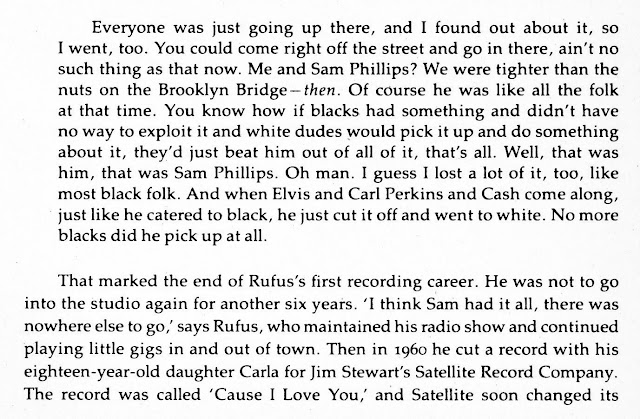


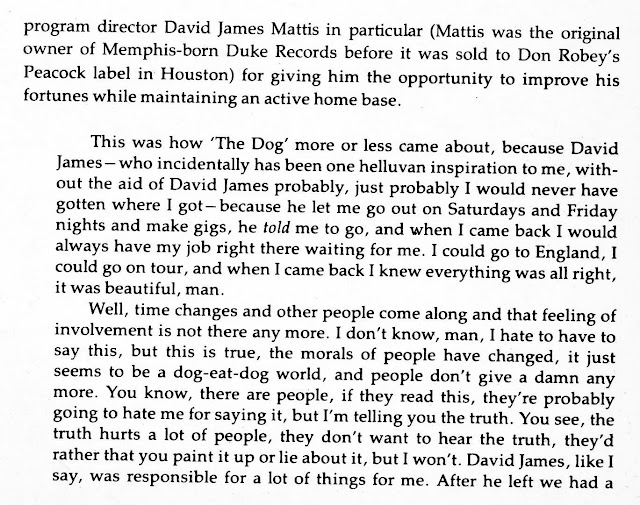





















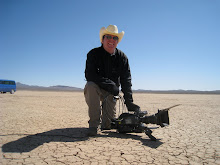


























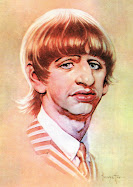






















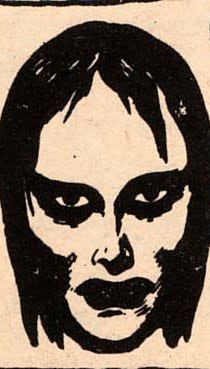









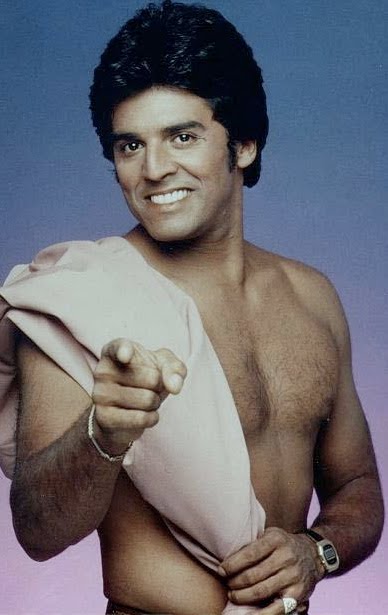









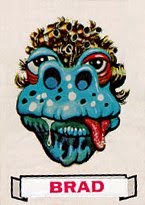























































No comments:
Post a Comment